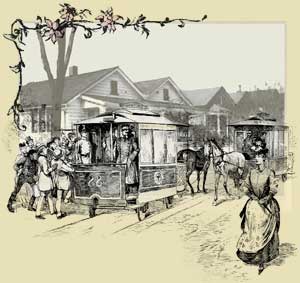The Winter of the Deep Snow.
At first the snows fell lightly, just a few inches in October 1880. But the family was to feel a deeper chill. Narcisse died that month, at 58 years of age. He was buried in an unmarked grave on the 22nd in Calvary Cemetery in Milwaukee.
Within weeks, the storms hit with a fury. On some days the temperature sank below 0° Fahrenheit (-18 Celsius), and fuel for heating was scarce. Between November and March an average of 10 feet of snow had fallen, carpeting the city. Several thousand men were enlisted to clear the tracks of the Chicago, Milwaukee and St. Paul railway lines which were blocked coming into Milwaukee.

The 1880’s would bring many changes. Edesse, now a widow with six children still at home, continued to live at the house she owned at 406 Russell Avenue just few blocks from Immaculate Conception, the Catholic church her family attended. The church was "substantial wooden structure" and played a significant role in their lives. The property was near Deer Creek, a popular swimming hole in the summer. The sprawling Rolling Mills lay to the north on the shores of the majestic Lake Michigan. By 1887 horses pulled trolleys along tracks that ran down the street in front of their home, while the Chicago & North West railway rumbled past just to the east. The new reliance on train travel soon altered the way time was perceived. Noon was no longer marked when the sun was directly overhead as the world in 1883 was divided into time zones to accommodate train schedules.
Her younger daughter, Matilda, married John Henry Odenbrett January 1, 1882. The first day of the New Year was especially festive for French families and a wedding added a joyful element. The Odenbrett's first child, Edesse or "Dessie", was born a year later and shortly afterwards the young couple moved to Chicago. Charles and Edward joined the work force at tender ages to help support the family, leaving only Paul at home.
- Calvary Cemetery Record of Burials [FHL US/CAN 1032559]: 1880 Oct 22 Petelle Narcise 59y, Lot 10, Block -, Range 46, Bay View, also Messmann Funeral Home; Block 3, Row 10, Lot 46. Grandson Paul Henry Petelle recalled visiting the grave with his father. The grave is unmarked.
- The Western Historical Company: Chicago, 1881, A.T. Andreas, Proprietor, History of Milwaukee, Wisconsin.FHL US/CAN 1000817
- Old World Wisconsin: Around Europe in the Badger State, by Fred L. Holmes; E.M. Hale and Company, Eau Claire, Wisconsin.
- http://www.nytimes.com/2009/02/25/nyregion/25about.html
- http://bayviewcompass.com/archives/535 (June 25, 2009) "By 1883, the Cream City Railroad Company had extended its horsecar tracks as far south as Kinnickinnic and Russell avenues. To serve the rolling mill workers, the horsecar was extended in 1887 along Russell Avenue to the lake. A turntable was installed at Superior Street allowing the horsecar to turn around. According to Bernhard Korn's book, The Story of Bay View, Father Fagan of Immaculate Conception Parish had expressed opposition to the lake extension, fearing the horsecars would scare the children who attended the parish school."
- Image collage Dover clipart, Russell street row houses at UWM Archives University of Wisconsin; http://www4.uwm.edu/libraries/arch/
